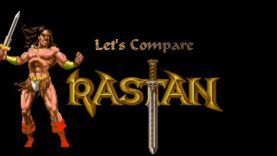Let’s Compare ( Mortal Kombat ) REMAKE
Gaming History Source
video Locations:
Arcade 0:24
NES 1:56
Gameboy 3:38
Game Gear 5:14
SMS 6:45
Amiga 8:17
Genesis / Megadrive 10:03
Sega CD / Mega CD 11:38
Super Nintendo 13:07
DOS 14:41
Description Source:
http://en.wikipedia.org/wiki/Mortal_K…
Mortal Kombat, commonly abbreviated MK, is a series of fighting games created by Ed Boon and John Tobias. The first four renditions and their updates were developed by Midway Games and initially released on arcade machines. The arcade titles were later picked up by Acclaim Entertainment for the home console conversions. Beginning with Mortal Kombat: Deadly Alliance, Midway Games exclusively created home versions of Mortal Kombat up until Mortal Kombat vs. DC Universe. Following Midway’s bankruptcy, the franchise was sold to Warner Bros. in July 2009 and became a part of the Warner Bros. Interactive Entertainment Branch.
The series began originally as a game based on the popular actor martial artist, Jean-Claude Van Damme. The idea fell through and Mortal Kombat was born instead. As a result of its success, Mortal Kombat has spawned many sequels and has been spun off into several adventure games, films (animated and live-action), and television series (animated and live-action). The Mortal Kombat series has inspired several songs, including “Techno Syndrome,” otherwise known as the “Mortal Kombat Theme.” Other spin-offs include various comic book series, a card game and a live-action tour.
The original three games and their updates, Mortal Kombat, Mortal Kombat II, Mortal Kombat 3, Ultimate Mortal Kombat 3, and Mortal Kombat Trilogy, were styled in a 2-D fighting fashion with gameplay consisting of five buttons that were high punch, low punch, high kick, low kick, and block. Reviewers have stated that because of this the characters are only differentiated by their special moves. In fact, some reviewers have criticized that the “bewildering array” of special moves in comparison to other fighting games has resulted in too little focus on regular moves.
The series is especially noted for its realistic digitized sprites (which differentiated it from its contemporaries’ hand-drawn sprites), and its high levels of blood and gore, including, most notably, its graphic Fatalities—finishing moves, requiring a sequence of buttons to perform, which, in part, led to the creation of the ESRB. The series name itself is also known for using the letter “K” in place of “C” for the hard C sound, thus intentionally misspelling the word “combat,” as well as other words with the hard C sound within later games in the series. Early games in the series were infamous for the prominent use of palette swapping to create new character sprites.
Gameplay
According to 1UP.com, the early Mortal Kombat characters played virtually identical to one another with the only major differences being special moves. In an interview with Computer and Video Games, Ed Boon stated, “[…] since the beginning, one of the things that’s separated us from other fighting games is the crazy moves we’ve put in it, like fireballs and all the magic moves, so to speak.” When asked if Street Fighter and Mortal Kombat would do a crossover, Street Fighter producer, Yoshinori Ono, called Mortal Kombat a very different game from Street Fighter. The Capcom Senior Director of communications compared Street Fighter and Mortal Kombat in an interview with Gamasutra by asking if the interviewer preferred the “precision and depth” of Street Fighter or the “gore and comedy” of Mortal Kombat; he also stated that the Street Fighter and Mortal Kombat rivalry was considered similar to the Coke and Pepsi rivalry in the 1990s] In an interview with Video Games Daily, Senior Producer of Mortal Kombat vs. DC Universe, Hans Lo, called Street Fighter a little more technical fighter in comparison to Mortal Kombat.
Midway would keep their single styled fighting moves with four attack buttons which were a different array of punches and kicks and block until they changed this in Mortal Kombat: Deadly Alliance by differentiating characters normal moves and even giving them multiple fighting styles. Beginning in Mortal Kombat: Deadly Alliance and until Mortal Kombat: Deception, the characters would have three fighting styles per character: two unarmed fighting styles, and one weapon style. Few exceptions to this arose in Mortal Kombat: Armageddon, such as monster-like characters like Onaga and Moloch who would have only one fighting style. Most of the fighting styles featured are based on real martial arts styles, though a few of them are not. Goro’s fighting styles, for example, are designed to take advantage of the fact that he has four arms. For Mortal Kombat: Armageddon, fighting styles were reduced to a maximum of two per character (generally one hand-to-hand combat style and one weapon style) due to the sheer number of playable characters.













